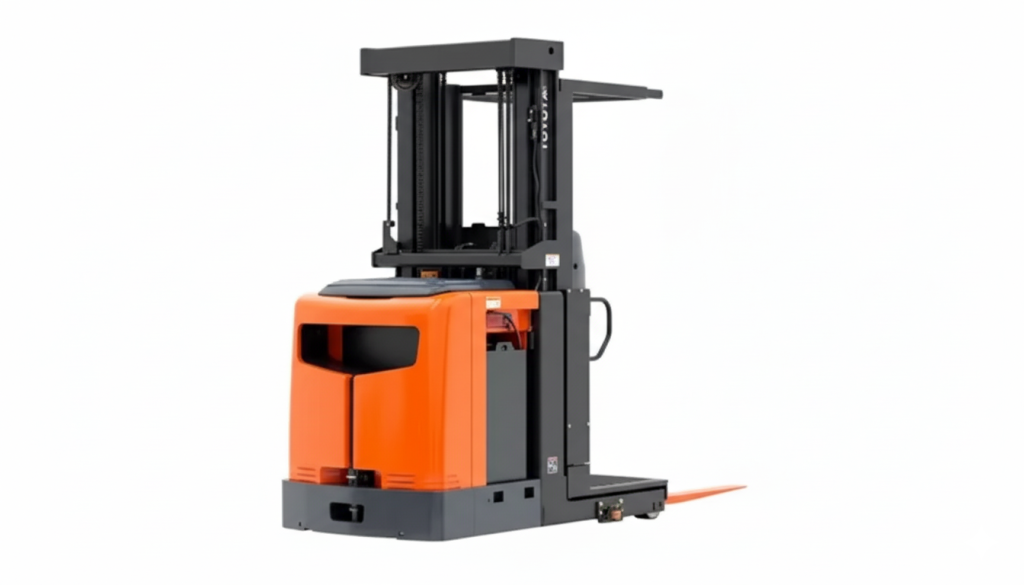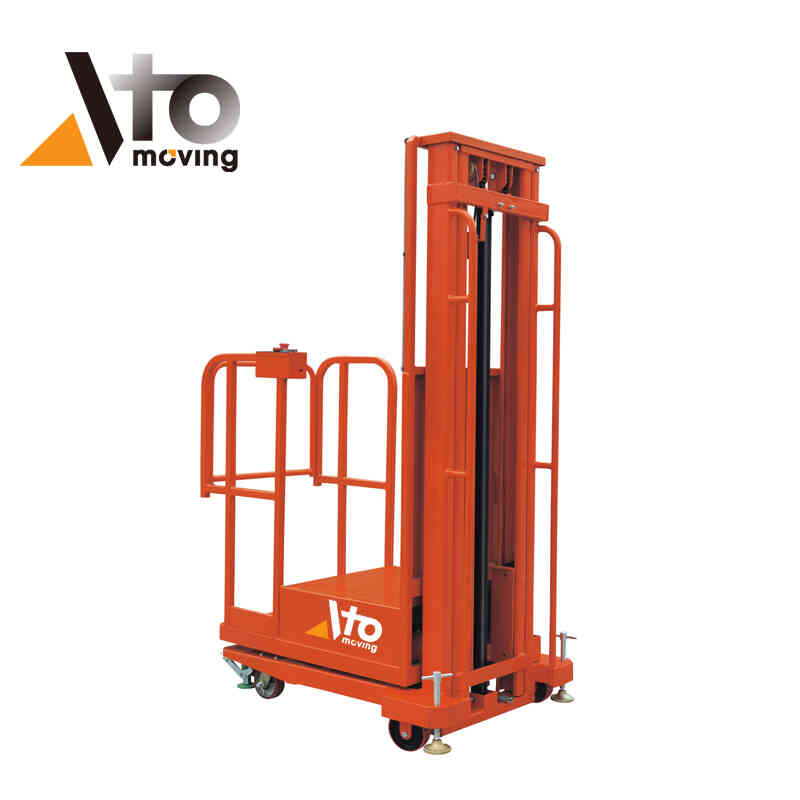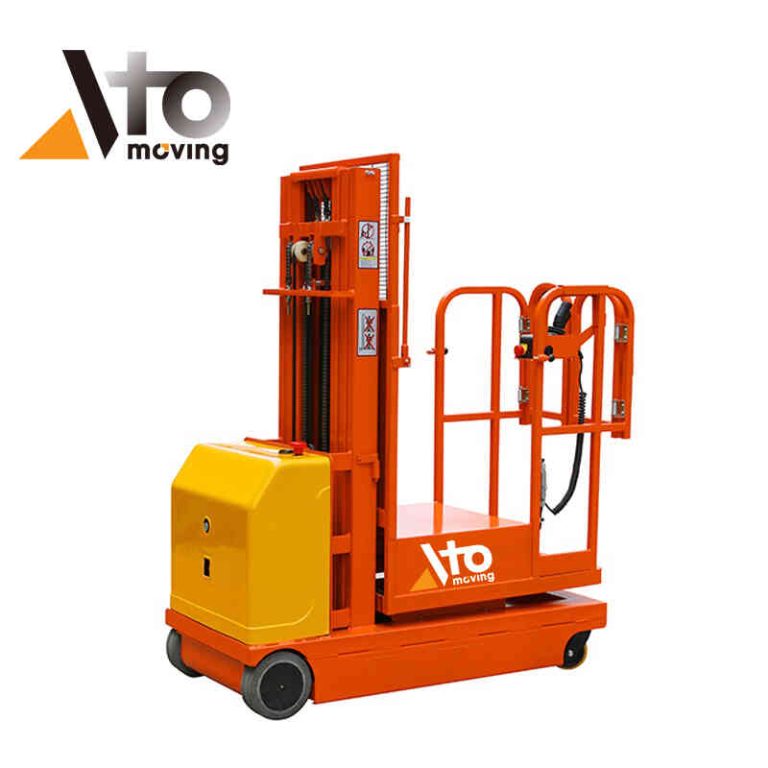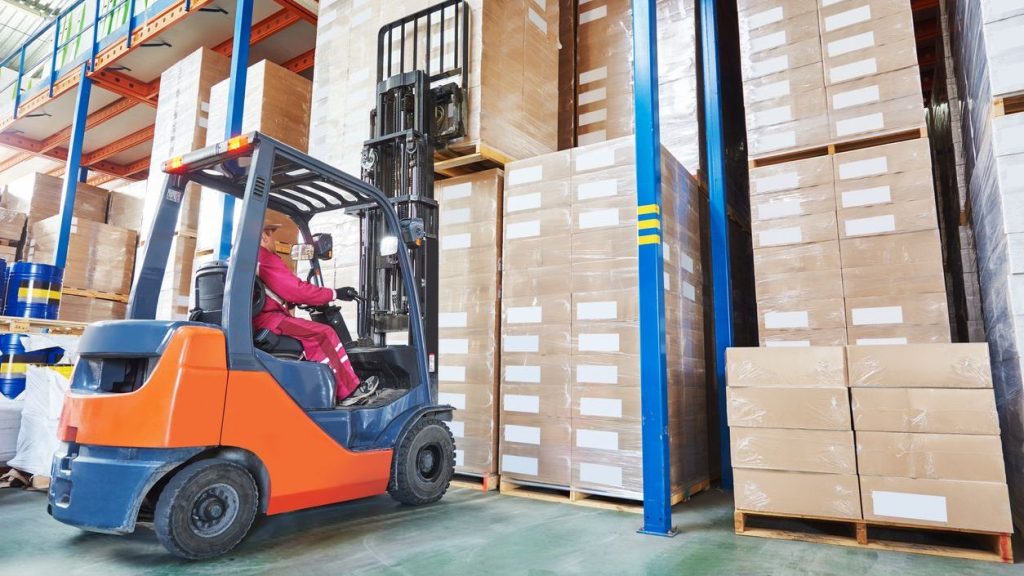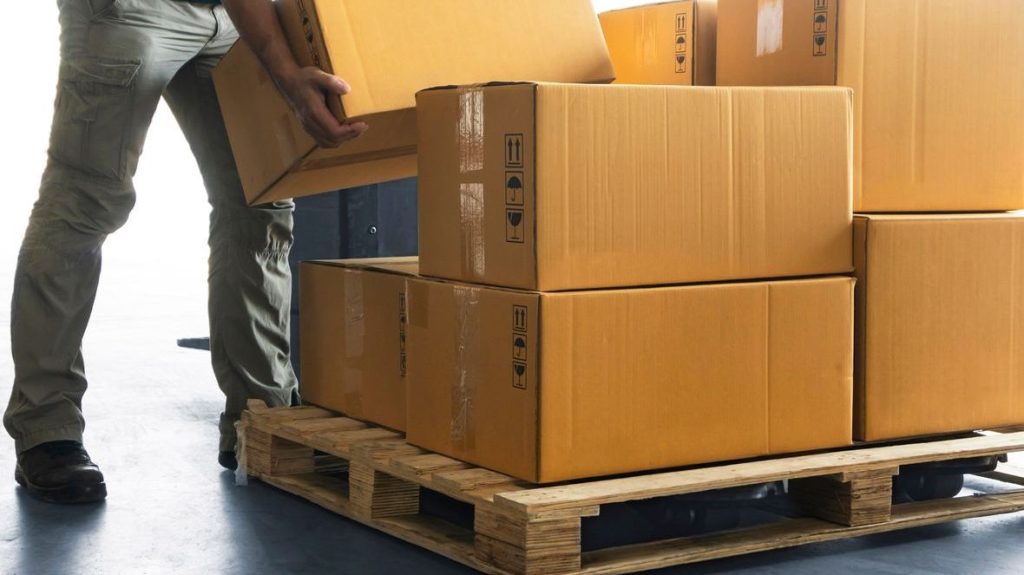In modern warehousing and distribution centers, efficiency and safety are paramount when retrieving products from high-density storage systems. An order picker is a specialized material handling vehicle designed to elevate operators to heights where they can manually select individual items from warehouse racking systems.
Unlike traditional forklifts that lift pallets, order pickers lift both the operator and a platform, enabling precise, person-to-goods picking at various levels. This equipment has become indispensable in facilities managing high SKU counts and small-quantity orders.
Understanding what an order picker is and how it functions can dramatically improve your warehouse operations and productivity.
Table of Contents
Understanding Order Picker Fundamentals
An order picker, also known as a stock picker or cherry picker, is a piece of material handling equipment specifically engineered to transport operators vertically alongside storage racks. The fundamental purpose of this machine is to bring workers to the exact height of products stored on shelving units, enabling them to pick individual items efficiently without climbing ladders or using unsafe methods.
The core principle behind order picker design centers on vertical operator transport. The machine features an enclosed platform or cage where the operator stands, along with controls that allow them to raise, lower, and maneuver the platform with precision. This platform typically includes space for a small quantity of picked items, though many order pickers can be configured with additional load capacity for multiple orders.
Order pickers operate on electric power systems, making them ideal for indoor warehouse environments where emissions must be minimized. The electric motor drives both the travel function and the hydraulic system that controls vertical lift.
Most modern units feature battery-powered operation with lithium-ion or lead-acid batteries, providing several hours of continuous operation between charges.
The height capability of order pickers represents one of their defining characteristics. Standard models typically reach heights between 15 and 30 feet, while high-capacity versions can access products stored up to 40 feet or higher.
This vertical reach makes them invaluable in facilities utilizing vertical storage space to maximize warehouse footprint efficiency.
Operational speed varies considerably based on model and application. Low-level order pickers designed for frequent ground-level travel may achieve speeds up to 8 mph when the platform is lowered, while high-reach models prioritize stability over speed.
Lift speeds are calibrated to balance productivity with operator safety, typically ranging from 30 to 90 feet per minute depending on load and height.
Types of Order Pickers
Low-Level Order Pickers
Low-level order pickers are designed for applications where products are stored at heights up to approximately 12 feet. These compact machines excel in environments with lower ceiling heights or where the majority of picking occurs at easily accessible levels. They feature a smaller footprint, making them maneuverable in tighter aisles and more congested warehouse areas. Low-level units often have faster travel speeds since they operate closer to the ground, and they typically cost less than their high-reach counterparts. Many facilities use low-level order pickers for fast-moving items stored in easily accessible locations, reserving slower picks for less frequently accessed inventory.
Medium-Level Order Pickers
Medium-level order pickers bridge the gap between low-level machines and high-reach models, typically offering lift heights between 12 and 20 feet. These versatile machines represent the most common order picker configuration in distribution centers and warehouses. They provide an optimal balance of reach, stability, speed, and cost-effectiveness for facilities with standard racking configurations. Medium-level order pickers can navigate most warehouse environments while providing access to multiple picking levels, making them suitable for operations handling diverse product mixes and varying order profiles.
High-Level Order Pickers
High-level order pickers are engineered for accessing products stored at heights exceeding 20 feet, with some models capable of reaching 40 feet or more. These machines incorporate enhanced stability features, including wider bases, reinforced masts, and sophisticated control systems that adjust performance based on platform height. High-level units are essential in high-bay warehouses where vertical storage maximization is critical. They often include additional safety features such as automated speed reduction as height increases and enhanced operator restraint systems. The investment in high-level order pickers pays dividends in facilities where cubic space utilization directly impacts operational costs.
Turret Order Pickers
Turret order pickers, sometimes called swing-reach or pivoting order pickers, feature platforms that can rotate or extend independently from the mast. This design allows operators to pick from both sides of an aisle without repositioning the entire machine. Turret models are particularly valuable in very narrow aisle (VNA) applications where aisle width is minimized to maximize storage density. The rotating platform enables efficient order fulfillment in confined spaces, though these machines typically require wire guidance systems or rail guidance to maintain proper positioning within narrow aisles.
Key Components and Features
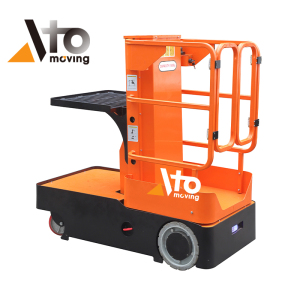
Operator Platform
The operator platform serves as the command center for order picker operations. This enclosed cage or platform provides a secure working area where the operator stands during picking activities. Modern platforms include non-slip flooring, ergonomic control placement, and adequate space for both the operator and small loads of picked items. Many platforms feature adjustable gates or doors that can be opened at height to facilitate product retrieval while maintaining operator security. Platform design prioritizes operator comfort during extended shifts, with some models including shock-absorbing floors and spacious layouts that reduce fatigue.
Lift Mast
The lift mast represents the structural backbone of the order picker, supporting the platform and operator during vertical travel. Constructed from high-strength steel, the mast must withstand significant loads while maintaining minimal sway at maximum height. Most order pickers utilize telescoping mast designs that collapse when lowered, reducing overall machine height for clearance through doorways and under lower ceilings. The mast incorporates guide rollers and support mechanisms that ensure smooth, stable vertical movement even when fully extended. Advanced models feature dual-stage or triple-stage masts that enable compact nested height while achieving impressive maximum lift heights.
Control Systems
Contemporary order pickers employ sophisticated control systems that manage all aspects of machine operation. These systems include controls for vertical lift, horizontal travel, steering, braking, and various safety functions. Controls are positioned within easy reach of the operator, typically on a panel or armrest integrated into the platform. Many modern units feature proportional controls that allow operators to modulate speed and movement with precision, improving both efficiency and safety. Electronic control systems monitor battery status, provide diagnostic information, and can integrate with warehouse management systems for optimized routing and task assignment.
Power Systems
Electric power systems dominate order picker designs due to their clean operation, low noise levels, and suitability for indoor environments. Battery technology significantly impacts operational performance, with facilities choosing between traditional lead-acid batteries and newer lithium-ion options. Lead-acid batteries offer lower initial costs but require dedicated charging areas, ventilation, and regular maintenance including watering. Lithium-ion batteries provide opportunity charging capabilities, faster charging times, longer lifespan, and maintenance-free operation, though at higher upfront costs. The power system must deliver sufficient capacity for both travel and lift functions throughout operational shifts, with battery size and voltage varying based on machine class and intended duty cycle.
Safety Features
Safety features are paramount in order picker design, protecting operators working at significant heights. Standard safety equipment includes emergency stop buttons, platform gates with interlocks that prevent travel when open, audible travel alarms, and restraint systems such as safety harnesses or belts. Advanced models incorporate tilt sensors that alert operators to unstable conditions, automatic speed reduction at height, obstacle detection systems, and stability monitoring. Many order pickers include dead-man controls that stop machine movement if the operator releases the control, preventing unintended travel. LED work lights illuminate picking areas, while horn systems alert nearby workers to machine movement.
Applications and Industries
Order pickers serve critical roles across numerous industries where piece-picking operations are essential. In retail distribution centers, these machines enable workers to fulfill e-commerce orders by picking individual items from vast inventories of consumer goods. Third-party logistics providers rely heavily on order pickers to manage inventory for multiple clients, often picking mixed SKUs for various customers simultaneously.
Manufacturing facilities utilize order pickers for parts retrieval in production support operations, bringing specific components to assembly lines as needed. The automotive industry, with its extensive parts catalogs, employs order pickers in both manufacturing and aftermarket distribution environments. Pharmaceutical distribution represents another significant application area, where order pickers facilitate accurate picking of medications and medical supplies with stringent tracking requirements.
Cold storage warehouses present unique applications for order pickers, with specialized models designed to operate in freezer environments as low as -30°F. These cold-storage units feature specially formulated hydraulic fluids, enhanced insulation, and components resistant to extreme temperature operation. Food and beverage distribution similarly depends on order pickers, particularly for facilities managing diverse product mixes requiring individual item picking rather than full-pallet handling.
The publishing and media industry uses order pickers extensively in book distribution centers, where individual titles must be selected from extensive inventories. Hardware and home improvement retailers employ these machines in both distribution centers and large retail locations where high-density storage of small parts and components is common. Wherever operations require accessing individual items stored vertically across multiple levels, order pickers provide an efficient solution.
Safety Considerations
Operating order pickers at height introduces significant safety responsibilities that require comprehensive training and strict adherence to protocols. Operators must complete certified training programs that cover machine operation, load handling, hazard recognition, and emergency procedures. This training should be specific to the exact model being operated, as controls and characteristics vary between manufacturers and machine classes.
Fall protection represents the primary safety concern with order picker operation. Operators should use appropriate restraint systems, including safety harnesses attached to designated anchor points within the platform. Platform gates must remain closed and secured during vertical travel and horizontal movement. Many facilities implement policies requiring gates to be closed except during the actual moment of product retrieval, minimizing exposure to fall hazards.
Load capacity limits must be strictly observed, accounting for both the weight of picked items and the operator. Exceeding rated capacities can compromise machine stability, particularly at maximum height. Operators should understand the machine’s capacity ratings and how load position affects stability. Uneven loading or extending loads beyond platform boundaries creates dangerous conditions that can lead to tip-overs.
Aisle conditions significantly impact order picker safety. Floors must be level, clean, and free of debris or damage that could cause instability. Adequate lighting is essential, particularly at higher levels where natural light may be limited. Aisle widths must accommodate the specific order picker model being used, with clearances allowing safe passage without contact with racking or stored products.
Interaction with other equipment and workers requires careful management through traffic control systems, designated pedestrian walkways, and clear communication protocols. Operators should use audible warnings when approaching intersections or blind corners, and travel speeds should be adjusted based on visibility and congestion. Regular safety inspections, pre-shift checks, and immediate reporting of any mechanical issues are essential practices that prevent accidents and maintain equipment reliability.
Order Picker vs Other Material Handling Equipment
Order Picker vs Forklift
While both order pickers and forklifts serve material handling functions, they operate under fundamentally different principles. Forklifts lift loads from ground level using forks, keeping the operator at ground level throughout operation. Order pickers elevate the operator to the product level, enabling manual selection of individual items. Forklifts excel at pallet-level handling, moving entire pallet loads efficiently. Order pickers are optimized for piece-picking, allowing workers to select specific quantities of individual SKUs. In most warehouses, these machines serve complementary roles rather than interchangeable functions.
Order Picker vs Reach Truck
Reach trucks extend forks forward to retrieve pallets from racking while keeping the operator at ground level. These machines are designed for pallet-in, pallet-out operations in narrow aisles. Order pickers, conversely, position operators at the exact shelf level for manual item selection. Reach trucks offer higher pallet throughput for full-pallet movements, while order pickers provide superior efficiency for mixed-item orders requiring multiple SKUs in varying quantities. The choice between these machines depends on whether operations focus on pallet handling or individual item picking.
Order Picker vs Pallet Jack
Pallet jacks, whether manual or powered, operate exclusively at ground level for horizontal pallet transport. They lack any vertical lift capability beyond the few inches needed to raise pallets for movement. Order pickers provide extensive vertical reach and operator elevation, serving entirely different operational needs. Facilities typically use pallet jacks for staging picked orders, moving pallets short distances, and ground-level transport, while order pickers handle vertical access to storage locations.
Order Picker vs Scissor Lift
Scissor lifts elevate operators for maintenance, installation, or construction tasks but lack the horizontal travel capabilities and warehouse-specific features of order pickers. Scissor lifts are stationary during elevated operation, requiring repositioning from ground level. Order pickers allow horizontal travel at any height, enabling continuous picking along rack faces without lowering the platform. Order pickers also include integrated controls optimized for picking operations, load capacity for products, and design features specific to warehouse environments that scissor lifts lack.
Selecting the Right Order Picker
Choosing the appropriate order picker requires careful analysis of multiple operational factors. Warehouse infrastructure establishes initial parameters, including ceiling height, aisle widths, floor conditions, and racking configurations. The maximum height at which products are stored determines the required lift height, with the selected order picker needing to comfortably reach the highest storage level while maintaining adequate overhead clearance.
Aisle width significantly influences order picker selection, particularly when considering the machine’s turning radius and overall dimensions. Narrow aisles may require specialized narrow-aisle order pickers or turret models, while wider aisles provide more flexibility in machine selection. Floor loading capacity must support the combined weight of the order picker, operator, and picked products, especially important in multi-story facilities or mezzanine areas.
Operational requirements shape the specification process, starting with typical order profiles. Facilities handling high volumes of small orders may prioritize different features than those processing fewer, larger orders. Pick rates and productivity targets influence decisions about travel speed, lift speed, and control responsiveness. The physical demands on operators during extended shifts may justify investments in ergonomic features, vibration dampening, and spacious platforms.
Battery technology selection impacts both operational flexibility and total cost of ownership. Facilities with opportunity charging capabilities and budget flexibility often benefit from lithium-ion batteries despite higher initial costs. Operations requiring round-the-clock equipment use may need battery exchange systems, influencing both battery type selection and facility infrastructure requirements. Energy costs, battery lifespan expectations, and maintenance resources all factor into power system decisions.
Budget considerations extend beyond initial purchase price to include ongoing operational costs, maintenance requirements, operator training needs, and potential productivity gains. Lower-cost machines may have higher long-term operating costs due to increased maintenance, shorter service life, or reduced productivity. Total cost of ownership analysis should evaluate all expense factors over the expected equipment lifespan, typically 7-10 years for quality order pickers in well-maintained environments.
Fleet compatibility and standardization offer operational advantages in facilities running multiple machines. Selecting order pickers from the same manufacturer or model family simplifies operator training, parts inventory, and maintenance procedures. However, optimal performance sometimes requires different machine types for varied applications within the same facility, necessitating balanced decisions between standardization and application-specific optimization.
Maintenance and Operational Best Practices
Proper maintenance ensures order picker reliability, safety, and longevity while minimizing unexpected downtime and repair costs. Preventive maintenance programs should follow manufacturer recommendations, typically including daily operator inspections, weekly detailed checks, and scheduled professional service at defined intervals. Daily pre-shift inspections cover critical safety items including brakes, steering, lift functions, platform gates, emergency stops, warning devices, and visible damage or fluid leaks.
Battery maintenance varies based on technology type but remains critical for optimal performance. Lead-acid batteries require regular watering with distilled water, terminal cleaning, equalization charging, and monitoring of electrolyte specific gravity. Proper charging protocols extend battery life, including avoiding opportunity charging with lead-acid batteries and ensuring adequate cooling time after charging. Lithium-ion batteries require minimal maintenance but benefit from proper charging practices and temperature management.
Hydraulic system maintenance includes regular fluid level checks, filter replacements, and inspection of hoses, fittings, and cylinders for leaks or damage. Hydraulic fluid should be changed according to manufacturer intervals or when contamination is detected. Maintaining proper hydraulic fluid levels and cleanliness prevents system damage and ensures smooth, reliable lift operation.
Tire inspection and replacement affect both safety and operational efficiency. Worn or damaged tires compromise stability, reduce traction, and can damage warehouse floors. Regular tire pressure checks maintain optimal performance in pneumatic tire applications, while solid and cushion tires should be monitored for wear patterns, cracks, or chunking that indicates replacement needs.
Operator training represents an ongoing maintenance activity often overlooked in equipment management. Regular refresher training reinforces safe operating practices, introduces operators to new safety features or procedural changes, and provides opportunities to address bad habits before they cause damage or accidents. Documenting all training activities protects the organization and ensures compliance with safety regulations.
Record keeping supports effective maintenance management by tracking service history, identifying recurring issues, monitoring parts usage, and documenting compliance with manufacturer service intervals. Digital maintenance management systems streamline this process, providing automated service reminders, parts inventory tracking, and fleet-wide performance analytics that inform replacement decisions and operational improvements.
Conclusion
Order pickers have revolutionized warehouse operations by enabling safe, efficient access to products stored at various heights throughout modern distribution facilities. Understanding what an order picker is, including its types, components, applications, and operational requirements, empowers warehouse managers to make informed decisions about equipment selection and deployment. These specialized machines deliver significant productivity improvements over alternative picking methods while maintaining operator safety through comprehensive design features and proper operational protocols. As warehousing continues evolving toward greater vertical density and piece-level accuracy, order pickers will remain essential tools for competitive fulfillment operations.
Frequently Asked Questions
What is the difference between an order picker and a forklift?
An order picker elevates the operator to the product level for manual selection of individual items, while a forklift keeps the operator at ground level and uses forks to lift entire pallets. Order pickers are designed for piece-picking operations where workers select specific items from shelving, whereas forklifts handle pallet-level loads. The fundamental difference is that order pickers bring the worker to the product, while forklifts bring the product to the worker.
What height can order pickers reach?
Order pickers typically reach heights between 15 and 40 feet, depending on the model and class. Low-level order pickers access heights up to 12 feet, medium-level models reach 12 to 20 feet, and high-level order pickers can extend beyond 20 feet with some specialized units reaching 40 feet or more. The maximum height required for your operation should be the primary factor in selecting the appropriate order picker class.
Do you need special training to operate an order picker?
Yes, order picker operators require specialized training and certification. OSHA regulations mandate that operators complete formal training specific to the equipment class they will operate, pass written and practical evaluations, and receive documented certification before independent operation. Training must cover machine controls, load handling, safety procedures, hazard recognition, and emergency protocols specific to elevated work platform operations.
What type of battery do order pickers use?
Most order pickers use electric batteries, either traditional lead-acid or modern lithium-ion technology. Lead-acid batteries have lower initial costs but require regular maintenance including watering, equalization charging, and designated charging areas with ventilation. Lithium-ion batteries cost more upfront but offer opportunity charging, longer lifespan, faster charging, zero maintenance, and improved energy efficiency, making them increasingly popular despite higher initial investment.
Can order pickers operate in cold storage environments?
Yes, specialized order pickers are designed for cold storage and freezer applications operating in temperatures as low as -30°F or colder. These machines feature cold-rated components, special hydraulic fluids formulated for low temperatures, enhanced insulation, and sealed electrical systems to prevent condensation damage. Standard order pickers should not be used in cold storage environments as they lack these critical adaptations for sub-zero operation.
How much weight can an order picker carry?
Order picker load capacity varies by model but typically ranges from 500 to 4,000 pounds, including the operator weight. This capacity represents the combined weight of the operator and picked products on the platform. Low-level order pickers generally have lower capacities around 500-1,000 pounds, while high-capacity models designed for heavier picking operations can handle 2,000-4,000 pounds. Always consult the specific machine’s capacity plate and never exceed rated limits.
What is the typical lifespan of an order picker?
With proper maintenance and operation, quality order pickers typically last 7-10 years in standard warehouse applications, with some units exceeding 15 years in well-maintained fleets. Lifespan depends on usage intensity, maintenance quality, operating environment, and build quality. Facilities running multiple shifts with heavy utilization may see shorter service life than single-shift operations. Regular preventive maintenance, prompt repairs, and operator training significantly extend equipment longevity.

